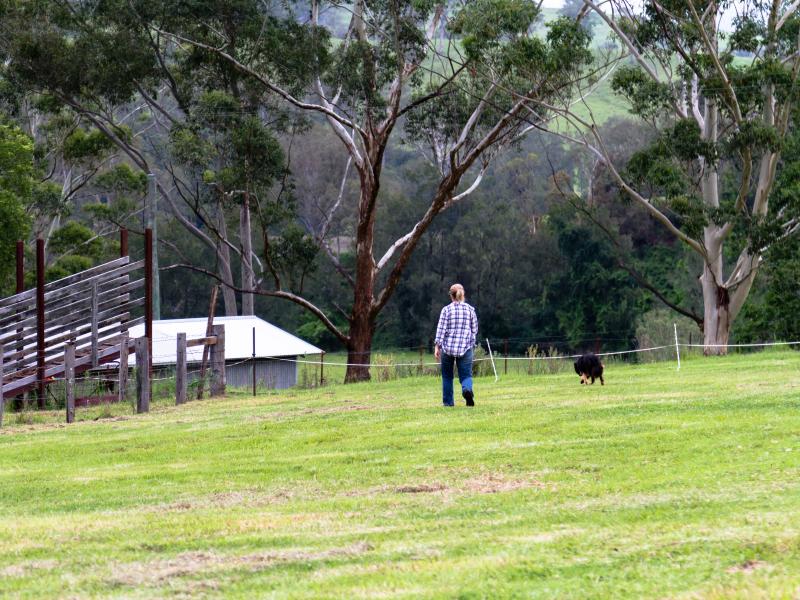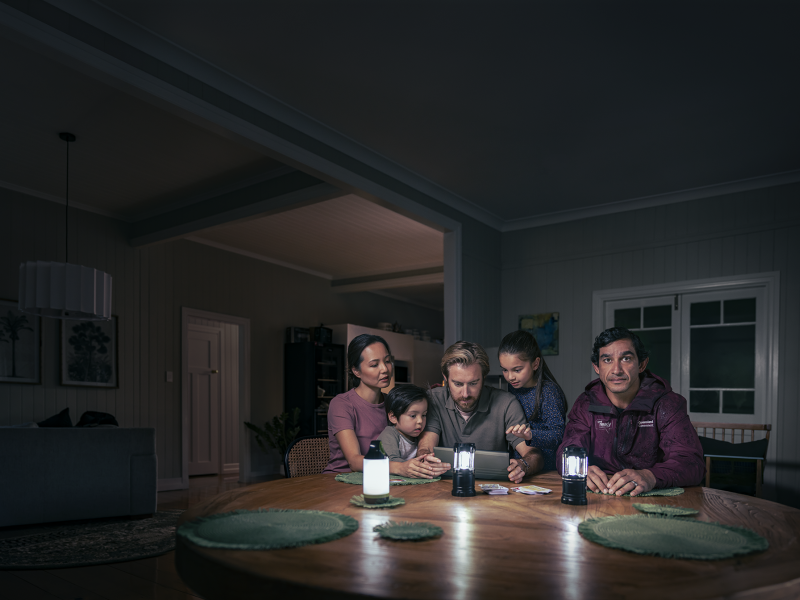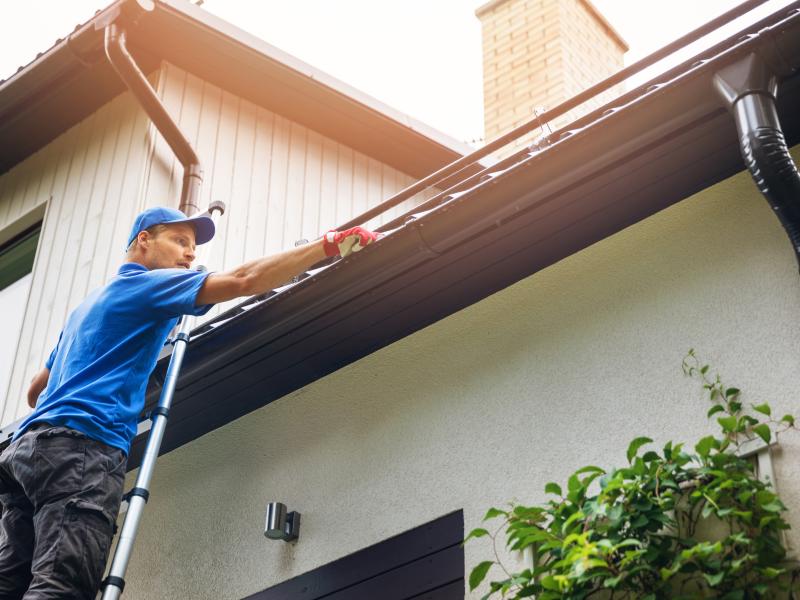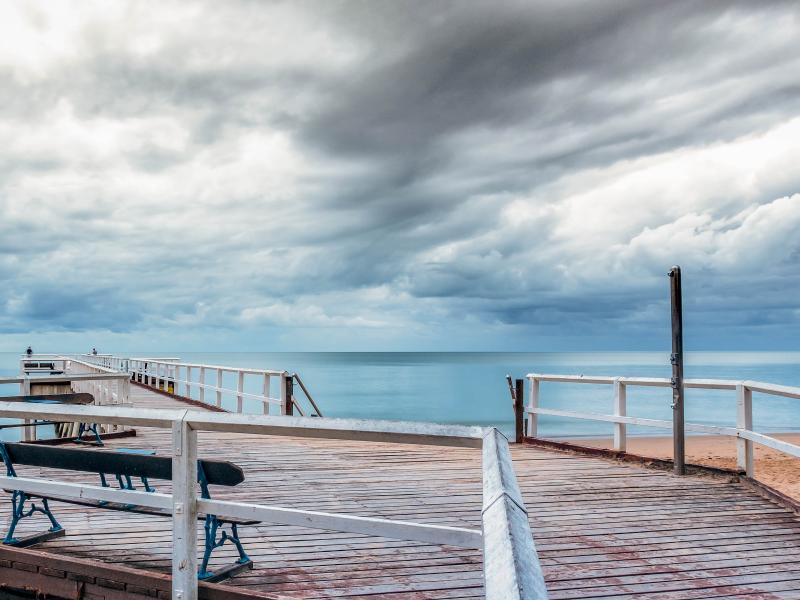Having an emergency kit stocked and ready is Step 3 to getting ready.
Queensland's extreme weather can cause your home to lose power (electricity), water and gas. You also may not be able to get to a supermarket or pharmacy for supplies. Prepare an emergency kit and store it somewhere safe so you have the things you need when the weather turns bad.
Download and print the Emergency Kit Checklist (PDF, 112.32KB) which is best filled in with pen on paper so you can take it shopping.
Watch this video for more tips on how to create an emergency kit
Items in your emergency kit
These are the basics, but you can think about what items your family might use if you had to stay at home for three days. You can also include more items if you want.
If you are at risk of isolation, you might want to pack enough for extra days. Think about your situation and pack a kit that is right for your household.
Keep your kit in a strong waterproof storage container and store it in a safe place in your home that you can get to easily. It is a good idea to keep it away from young children.
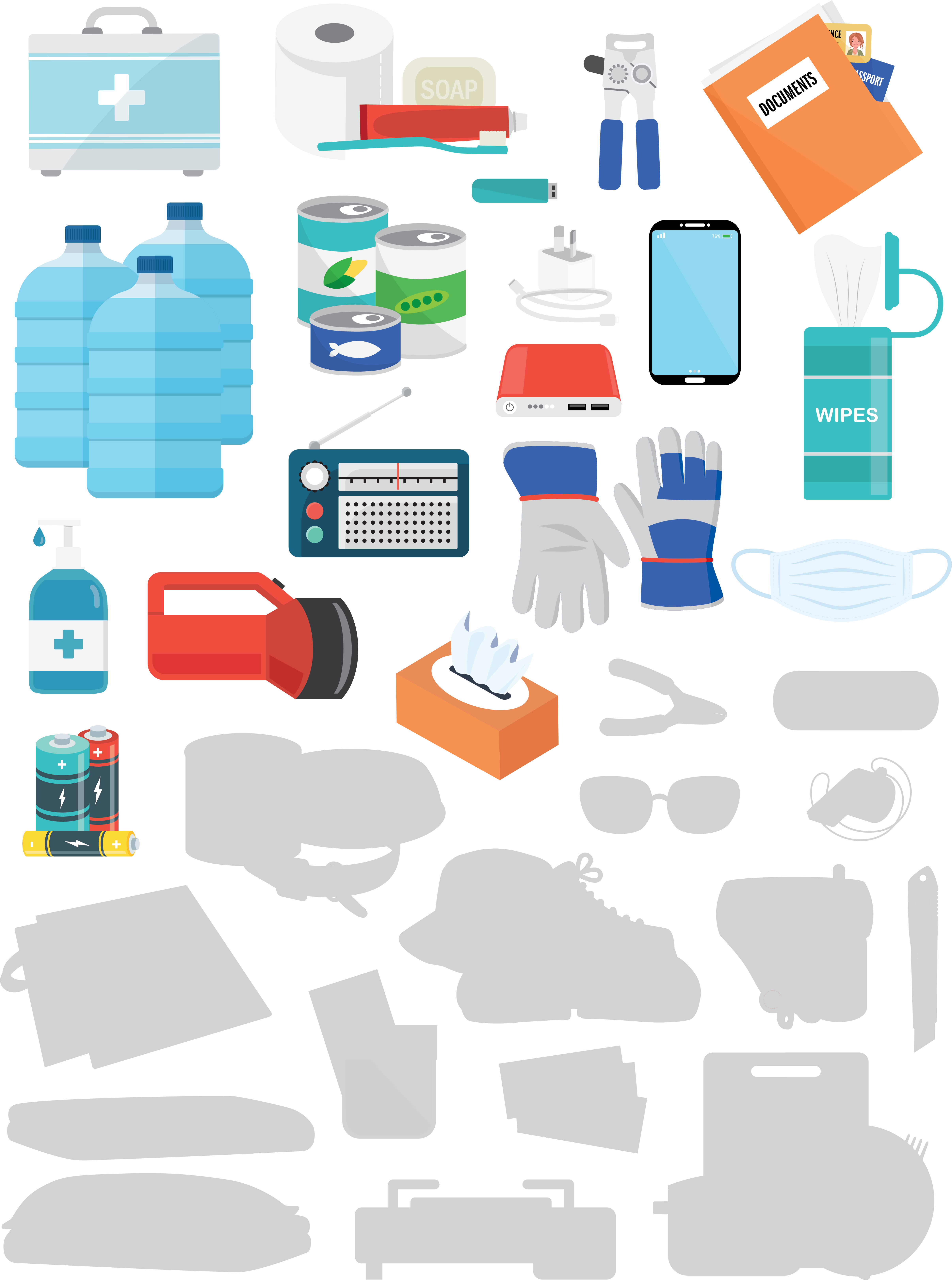
A properly equipped first aid kit can save lives. Make sure you include a first aid manual.

Your evacuation kit should contain up to date copies of the same important documents in your emergency kit.

A pair of sturdy work gloves will help prevent injury and infection when needing to handle rubbish and debris.

Pack enough tissues for each household member.
Electricity may not be available where you are headed to and you could be left in the dark for quite a while so include a torch (or two) or a battery powered lantern.

Pack enough wipes for each household member.
Make sure you have enough spare batteries to last three days. Ensure you have packed the correct battery type and quantities required for your torch, radio, kid’s toys that are packed and other included electricals.

Include toiletries you will need for three days such as toilet paper, toothpaste, toothbrushes, soap, shampoo, personal hygiene products, sunscreen and insect repellent.

Although most tins have a ring pull, there are still quite a few for which you will need a can opener.

Pack 10 litres of drinking water per person at a minimum.

Make a three-day menu plan for your household and store a supply of non-perishable food in your kit.

You mobile phone is key to keeping connected during a disaster. Extend the life of your phone by ensuring you have a spare phone charger packed as well as a fully charged portable battery or power pack.

A battery powered radio is one of the most reliable items in a disaster especially during power and internet loss.
Pack enough hand sanitiser for each member of the household.
Pack enough face masks for each household member.
Scan and save important documents, contact, emails and photos to a USB and keep it in your kit.
A properly equipped first aid kit can save lives. Make sure you include a first aid manual.

Your evacuation kit should contain up to date copies of the same important documents in your emergency kit.

A pair of sturdy work gloves will help prevent injury and infection when needing to handle rubbish and debris.

Pack enough tissues for each household member.
Electricity may not be available where you are headed to and you could be left in the dark for quite a while so include a torch (or two) or a battery powered lantern.

Pack enough wipes for each household member.
Make sure you have enough spare batteries to last three days. Ensure you have packed the correct battery type and quantities required for your torch, radio, kid’s toys that are packed and other included electricals.

Include toiletries you will need for three days such as toilet paper, toothpaste, toothbrushes, soap, shampoo, personal hygiene products, sunscreen and insect repellent.

Although most tins have a ring pull, there are still quite a few for which you will need a can opener.

Pack 10 litres of drinking water per person at a minimum.

Make a three-day menu plan for your household and store a supply of non-perishable food in your kit.

You mobile phone is key to keeping connected during a disaster. Extend the life of your phone by ensuring you have a spare phone charger packed as well as a fully charged portable battery or power pack.

A battery powered radio is one of the most reliable items in a disaster especially during power and internet loss.
Pack enough hand sanitiser for each member of the household.
Pack enough face masks for each household member.
Scan and save important documents, contact, emails and photos to a USB and keep it in your kit.
A properly equipped first aid kit can save lives. Make sure you include a first aid manual.

Your evacuation kit should contain up to date copies of the same important documents in your emergency kit.

A pair of sturdy work gloves will help prevent injury and infection when needing to handle rubbish and debris.

Pack enough tissues for each household member.
Electricity may not be available where you are headed to and you could be left in the dark for quite a while so include a torch (or two) or a battery powered lantern.

Pack enough wipes for each household member.
Make sure you have enough spare batteries to last three days. Ensure you have packed the correct battery type and quantities required for your torch, radio, kid’s toys that are packed and other included electricals.

Include toiletries you will need for three days such as toilet paper, toothpaste, toothbrushes, soap, shampoo, personal hygiene products, sunscreen and insect repellent.

Although most tins have a ring pull, there are still quite a few for which you will need a can opener.

Pack 10 litres of drinking water per person at a minimum.

Make a three-day menu plan for your household and store a supply of non-perishable food in your kit.

You mobile phone is key to keeping connected during a disaster. Extend the life of your phone by ensuring you have a spare phone charger packed as well as a fully charged portable battery or power pack.

A battery powered radio is one of the most reliable items in a disaster especially during power and internet loss.
Pack enough hand sanitiser for each member of the household.
Pack enough face masks for each household member.
Scan and save important documents, contact, emails and photos to a USB and keep it in your kit.
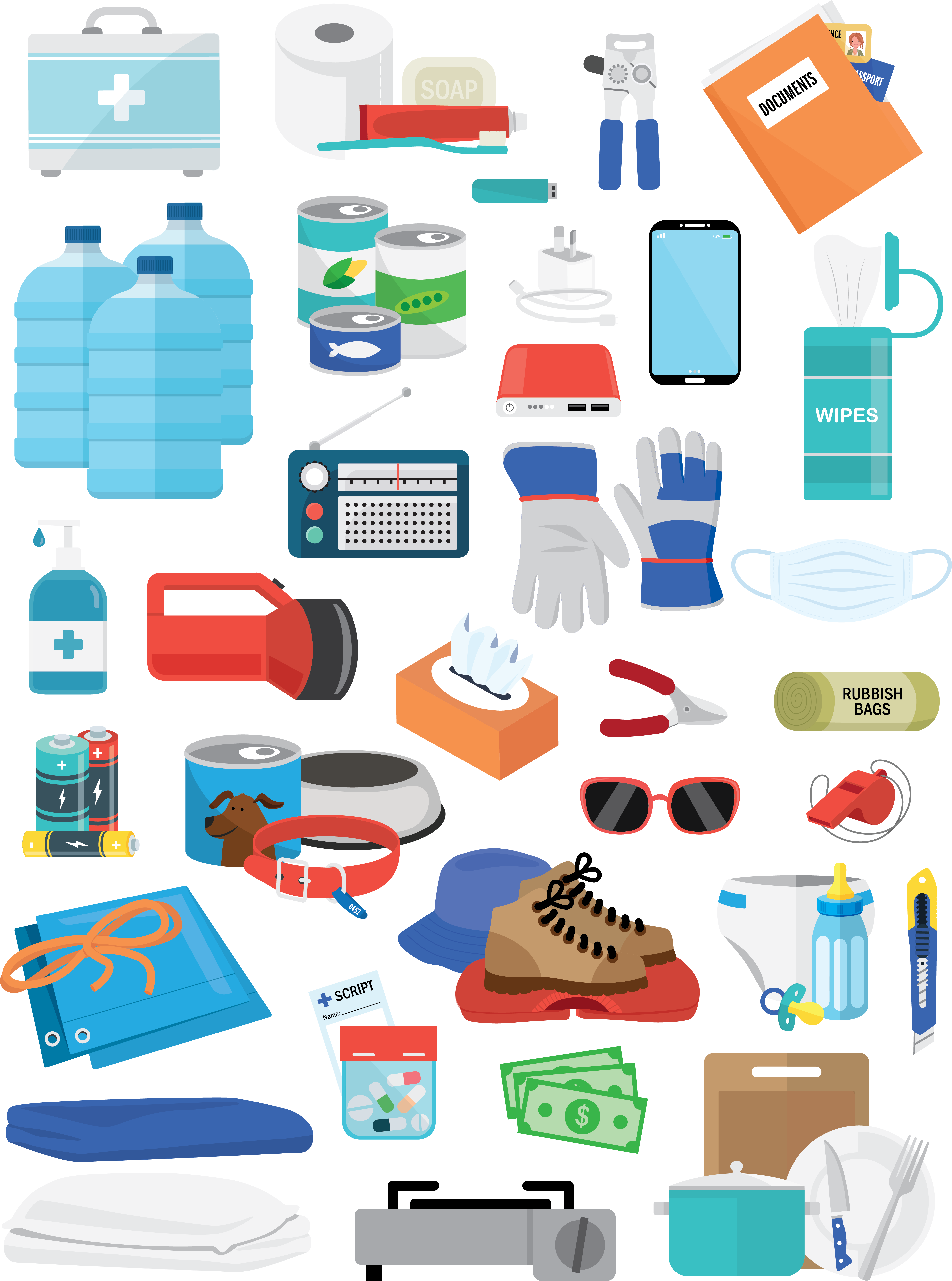
A properly equipped first aid kit can save lives. Make sure you include a first aid manual and include a week’s supply of prescription and over the counter medication.

Include toiletries you will need for three days such as toilet paper, toothpaste, toothbrushes, soap, shampoo, personal hygiene products, sunscreen and insect repellent.

Add a can opener to help open canned food.

Your emergency kit should contain up to date copies of important documents. For example documents could include your driver licence, insurance policies (home, content, vehicles, life), passports, legal documents (property deed, wills etc.), birth and marriage certificates.

Pack 10 litres of drinking water per person at a minimum.

Make a three-day menu plan for your household and store a supply of non-perishable food in your kit.

You mobile phone is key to keeping connected during a disaster. Extend the life of your phone by ensuring you have a spare phone charger packed as well as a fully charged portable battery or power pack.

Scan and save important documents, contact, emails and photos to a USB and keep it in your emergency kit.
Even if your home is not damaged in a disaster, electricity may not be available and you could be left in the dark for quite a while so include a torch (or two) or a battery powered lantern.

Make sure you have enough spare batteries to last three days.

Pack pet food and other items. See the protect your pet page to learn more.

Pack a radio that uses batteries. Get weather updates even if the internet and power stops working.

Thick work gloves protect your hands when moving rubbish.

Rubbish bags to clean up your backyard.
Pack a pair of safety glasses or sunglasses to protect your eyes when cleaning up.
Use a whistle to let people know where you are if you need help.

Pack a wrench and pliers to help turn off power, water and gas supplies.

Use a tarpaulin and ropes to cover any damaged areas of your home during severe weather. Only use if it is safe to do so.

Include any prescribed medication or aids required by household members such as prescription glasses, medic-alert bracelet or necklace (keep a spare in your kit), dosage measures (syringes, measuring cups), Epipen or batteries for hearing aids.

Pack spare clothes in your kit. Have a warm jumper, rain jacket, hat, gloves and shoes for everyone.

Pack formulas (check expiry date) and a bottle. Have enough food, nappies and wipes for at least three days. Pack different sizes of nappies because your baby might have grown before you need to use them.

A safety knife is a useful tool during and after a disaster.
Pack blankets to keep you warm.
Pack a small amount of cash (notes and coins) in case you cannot use bank cards.

Add camping mattresses and sleeping bags to your kit.
Pack a gas powered stove to cook on if there is no power.
Pack items you need to cook, eat and store your food.

Pack enough tissues for each household member.
Pack enough wipes for each household member.
Pack enough face masks for each household member.
Pack enough hand sanitiser for each household member.
A properly equipped first aid kit can save lives. Make sure you include a first aid manual and include a week’s supply of prescription and over the counter medication.

Include toiletries you will need for three days such as toilet paper, toothpaste, toothbrushes, soap, shampoo, personal hygiene products, sunscreen and insect repellent.

Add a can opener to help open canned food.

Your emergency kit should contain up to date copies of important documents. For example documents could include your driver licence, insurance policies (home, content, vehicles, life), passports, legal documents (property deed, wills etc.), birth and marriage certificates.

Pack 10 litres of drinking water per person at a minimum.

Make a three-day menu plan for your household and store a supply of non-perishable food in your kit.

You mobile phone is key to keeping connected during a disaster. Extend the life of your phone by ensuring you have a spare phone charger packed as well as a fully charged portable battery or power pack.

Scan and save important documents, contact, emails and photos to a USB and keep it in your emergency kit.
Even if your home is not damaged in a disaster, electricity may not be available and you could be left in the dark for quite a while so include a torch (or two) or a battery powered lantern.

Make sure you have enough spare batteries to last three days.

Pack pet food and other items. See the protect your pet page to learn more.

Pack a radio that uses batteries. Get weather updates even if the internet and power stops working.

Thick work gloves protect your hands when moving rubbish.

Rubbish bags to clean up your backyard.
Pack a pair of safety glasses or sunglasses to protect your eyes when cleaning up.
Use a whistle to let people know where you are if you need help.

Pack a wrench and pliers to help turn off power, water and gas supplies.

Use a tarpaulin and ropes to cover any damaged areas of your home during severe weather. Only use if it is safe to do so.

Include any prescribed medication or aids required by household members such as prescription glasses, medic-alert bracelet or necklace (keep a spare in your kit), dosage measures (syringes, measuring cups), Epipen or batteries for hearing aids.

Pack spare clothes in your kit. Have a warm jumper, rain jacket, hat, gloves and shoes for everyone.

Pack formulas (check expiry date) and a bottle. Have enough food, nappies and wipes for at least three days. Pack different sizes of nappies because your baby might have grown before you need to use them.

A safety knife is a useful tool during and after a disaster.
Pack blankets to keep you warm.
Pack a small amount of cash (notes and coins) in case you cannot use bank cards.

Add camping mattresses and sleeping bags to your kit.
Pack a gas powered stove to cook on if there is no power.
Pack items you need to cook, eat and store your food.

Pack enough tissues for each household member.
Pack enough wipes for each household member.
Pack enough face masks for each household member.
Pack enough hand sanitiser for each household member.
A properly equipped first aid kit can save lives. Make sure you include a first aid manual and include a week’s supply of prescription and over the counter medication.

Include toiletries you will need for three days such as toilet paper, toothpaste, toothbrushes, soap, shampoo, personal hygiene products, sunscreen and insect repellent.

Add a can opener to help open canned food.

Your emergency kit should contain up to date copies of important documents. For example documents could include your driver licence, insurance policies (home, content, vehicles, life), passports, legal documents (property deed, wills etc.), birth and marriage certificates.

Pack 10 litres of drinking water per person at a minimum.

Make a three-day menu plan for your household and store a supply of non-perishable food in your kit.

You mobile phone is key to keeping connected during a disaster. Extend the life of your phone by ensuring you have a spare phone charger packed as well as a fully charged portable battery or power pack.

Scan and save important documents, contact, emails and photos to a USB and keep it in your emergency kit.
Even if your home is not damaged in a disaster, electricity may not be available and you could be left in the dark for quite a while so include a torch (or two) or a battery powered lantern.

Make sure you have enough spare batteries to last three days.

Pack pet food and other items. See the protect your pet page to learn more.

Pack a radio that uses batteries. Get weather updates even if the internet and power stops working.

Thick work gloves protect your hands when moving rubbish.

Rubbish bags to clean up your backyard.
Pack a pair of safety glasses or sunglasses to protect your eyes when cleaning up.
Use a whistle to let people know where you are if you need help.

Pack a wrench and pliers to help turn off power, water and gas supplies.

Use a tarpaulin and ropes to cover any damaged areas of your home during severe weather. Only use if it is safe to do so.

Include any prescribed medication or aids required by household members such as prescription glasses, medic-alert bracelet or necklace (keep a spare in your kit), dosage measures (syringes, measuring cups), Epipen or batteries for hearing aids.

Pack spare clothes in your kit. Have a warm jumper, rain jacket, hat, gloves and shoes for everyone.

Pack formulas (check expiry date) and a bottle. Have enough food, nappies and wipes for at least three days. Pack different sizes of nappies because your baby might have grown before you need to use them.

A safety knife is a useful tool during and after a disaster.
Pack blankets to keep you warm.
Pack a small amount of cash (notes and coins) in case you cannot use bank cards.

Add camping mattresses and sleeping bags to your kit.
Pack a gas powered stove to cook on if there is no power.
Pack items you need to cook, eat and store your food.

Pack enough tissues for each household member.
Pack enough wipes for each household member.
Pack enough face masks for each household member.
Pack enough hand sanitiser for each household member.
If you need to evacuate.
During severe weather, make sure you have your emergency kit on hand, so you can take it with you.
If you don't have an emergency kit and need to leave in a hurry, the list below can help.
Grab and go evacuation bag
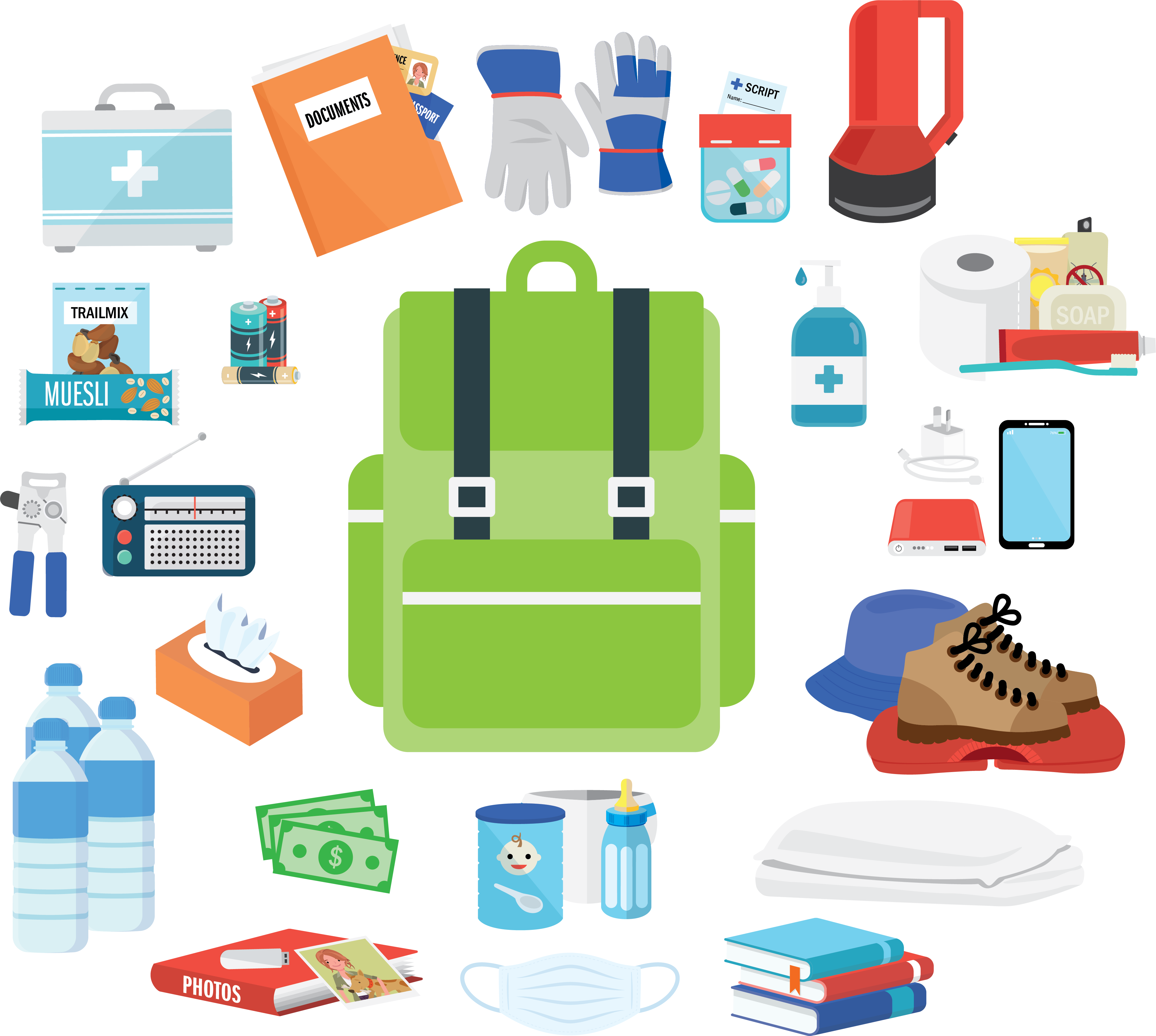
Include first aid items that can help if someone gets hurt. Add a week's supply of medications that your household needs. This might include reading glasses, spare medic-alert bracelet or necklaces, syringes, measuring cups, Epipen or hearing aids batteries.

Put copies of important documents in your kit, such as driver licences, insurance documents (home, content, vehicles, life), passports, legal documents (property deed, wills etc.), birth and marriage certificates.

Thick work gloves protect your hands when moving rubbish.

Include any prescribed medication or aids required by household members such as prescription glasses, medic-alert bracelet or necklace (keep a spare in your kit), dosage measures (syringes, measuring cups), Epipen or batteries for hearing aids.

Pack torches (flashlights) or battery powered lanterns.

Pack food that will not go bad without a refrigerator, such as canned and packaged food. Have enough for three days.

Have enough spare batteries to last three days.

Pack enough hand sanitiser for each household member.
Have enough toilet paper, toothpaste, toothbrushes, soap, shampoo, personal hygiene products, sunscreen and insect repellent for three days.

Add a can opener to help open canned food.

Pack a radio that uses batteries. Get weather updates even if the internet and power stops working.

Pack enough tissues for each household member.
To stay connected during a disaster, put a spare phone charger in your kit and have a portable battery (power bank).

Pack 10 litres of drinking water per person at least.
Pack a small amount of cash (notes and coins) in case you cannot use bank cards.

Pack formulas (check expiry date) and a bottle. Have enough food, nappies and wipes for at least three days. Pack different sizes of nappies because your baby might have grown before you need to use them.

Pack spare clothes in your kit. Have a warm jumper, rain jacket, hat, gloves and shoes for everyone.

Add camping mattresses and sleeping bags to your kit.
Make a list on your emergency plan of special items you will take. These might be photo or small things that are important to you, and that cannot be replaced.
Pack enough face masks for each household member.
Pack some books and games that don't need power to help entertain the kids whilst evacuated

Include first aid items that can help if someone gets hurt. Add a week's supply of medications that your household needs. This might include reading glasses, spare medic-alert bracelet or necklaces, syringes, measuring cups, Epipen or hearing aids batteries.

Put copies of important documents in your kit, such as driver licences, insurance documents (home, content, vehicles, life), passports, legal documents (property deed, wills etc.), birth and marriage certificates.

Thick work gloves protect your hands when moving rubbish.

Include any prescribed medication or aids required by household members such as prescription glasses, medic-alert bracelet or necklace (keep a spare in your kit), dosage measures (syringes, measuring cups), Epipen or batteries for hearing aids.

Pack torches (flashlights) or battery powered lanterns.

Pack food that will not go bad without a refrigerator, such as canned and packaged food. Have enough for three days.

Have enough spare batteries to last three days.

Pack enough hand sanitiser for each household member.
Have enough toilet paper, toothpaste, toothbrushes, soap, shampoo, personal hygiene products, sunscreen and insect repellent for three days.

Add a can opener to help open canned food.

Pack a radio that uses batteries. Get weather updates even if the internet and power stops working.

Pack enough tissues for each household member.
To stay connected during a disaster, put a spare phone charger in your kit and have a portable battery (power bank).

Pack 10 litres of drinking water per person at least.
Pack a small amount of cash (notes and coins) in case you cannot use bank cards.

Pack formulas (check expiry date) and a bottle. Have enough food, nappies and wipes for at least three days. Pack different sizes of nappies because your baby might have grown before you need to use them.

Pack spare clothes in your kit. Have a warm jumper, rain jacket, hat, gloves and shoes for everyone.

Add camping mattresses and sleeping bags to your kit.
Make a list on your emergency plan of special items you will take. These might be photo or small things that are important to you, and that cannot be replaced.
Pack enough face masks for each household member.
Pack some books and games that don't need power to help entertain the kids whilst evacuated

Include first aid items that can help if someone gets hurt. Add a week's supply of medications that your household needs. This might include reading glasses, spare medic-alert bracelet or necklaces, syringes, measuring cups, Epipen or hearing aids batteries.

Put copies of important documents in your kit, such as driver licences, insurance documents (home, content, vehicles, life), passports, legal documents (property deed, wills etc.), birth and marriage certificates.

Thick work gloves protect your hands when moving rubbish.

Include any prescribed medication or aids required by household members such as prescription glasses, medic-alert bracelet or necklace (keep a spare in your kit), dosage measures (syringes, measuring cups), Epipen or batteries for hearing aids.

Pack torches (flashlights) or battery powered lanterns.

Pack food that will not go bad without a refrigerator, such as canned and packaged food. Have enough for three days.

Have enough spare batteries to last three days.

Pack enough hand sanitiser for each household member.
Have enough toilet paper, toothpaste, toothbrushes, soap, shampoo, personal hygiene products, sunscreen and insect repellent for three days.

Add a can opener to help open canned food.

Pack a radio that uses batteries. Get weather updates even if the internet and power stops working.

Pack enough tissues for each household member.
To stay connected during a disaster, put a spare phone charger in your kit and have a portable battery (power bank).

Pack 10 litres of drinking water per person at least.
Pack a small amount of cash (notes and coins) in case you cannot use bank cards.

Pack formulas (check expiry date) and a bottle. Have enough food, nappies and wipes for at least three days. Pack different sizes of nappies because your baby might have grown before you need to use them.

Pack spare clothes in your kit. Have a warm jumper, rain jacket, hat, gloves and shoes for everyone.

Add camping mattresses and sleeping bags to your kit.
Make a list on your emergency plan of special items you will take. These might be photo or small things that are important to you, and that cannot be replaced.
Pack enough face masks for each household member.
Pack some books and games that don't need power to help entertain the kids whilst evacuated


